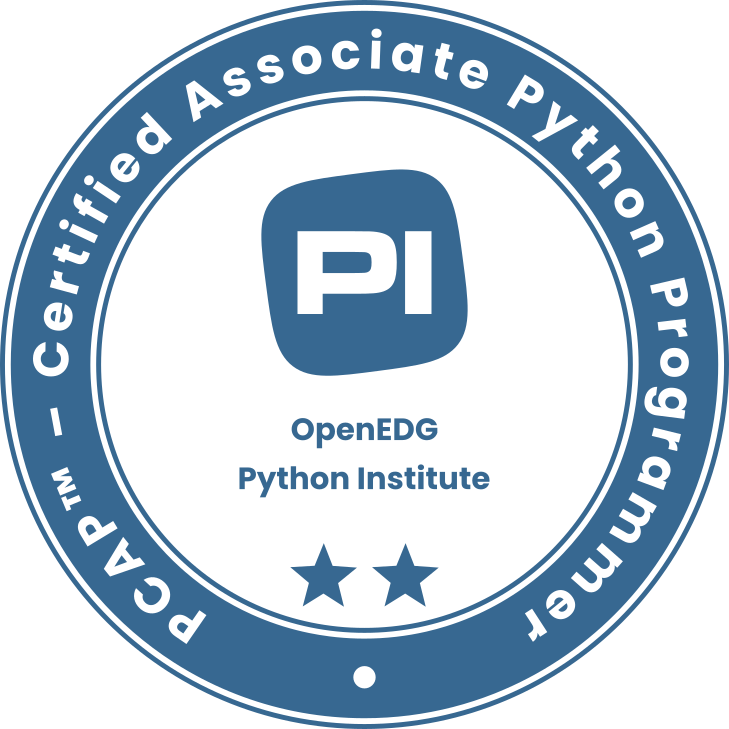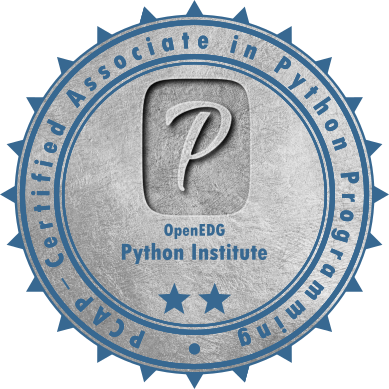PCAP™ – Certified Associate in Python Programming (Exam PCAP-31-0x) – EXAM SYLLABUS
Certificate holder's profile: the test candidate who has passed the PCAP-31-0x exam demonstrates the following proficiency in Python programming:
- an ability to design, develop and improve multi-module computer applications coded in Python
- an ability to analyze and model real-life problems in OOP categories
- experience allowing her/him to take a job as a junior developer
- sufficient skills to create and develop her/his own programming portfolio
- the potential to use Python in everyday life applications including DIY activities
PCAP-31-03 Exam Syllabus
Status: LIVE & ACTIVE

The exam consists of five sections:
- Section 1 → 6 items, Max Raw Score: 12 (12%)
- Section 2 → 5 items, Max Raw Score: 14 (14%)
- Section 3 → 8 items, Max Raw Score: 18 (18%)
- Section 4 → 12 items, Max Raw Score: 34 (34%)
- Section 5 → 9 items, Max Raw Score: 22 (22%)
Objectives covered by the block (6 exam items)
PCAP-31-03 1.1 – Import and use modules and packages
- import variants: import, from import, import as, import *
- advanced qualifying for nested modules
- the dir() function
- the sys.path variable
PCAP-31-03 1.2 – Perform evaluations using the math module
- functions: ceil(), floor(), trunc(), factorial(), hypot(), sqrt()
PCAP-31-03 1.3 – Generate random values using the random module
- functions: random(), seed(), choice(), sample()
PCAP-31-03 1.4 – Discover host platform properties using the platform module
- functions: platform(), machine(), processor(), system(), version(), python_implementation(), python_version_tuple()
PCAP-31-03 1.5 – Create and use user-defined modules and packages
- idea and rationale;
- the __pycache__ directory
- the __name__ variable
- public and private variables
- the __init__.py file
- searching for/through modules/packages
- nested packages vs. directory trees
Objectives covered by the block (5 exam items)
PCAP-31-03 2.1 – Handle errors using Python-defined exceptions
- except, except:-except, except:-else:, except (e1, e2)
- the hierarchy of exceptions
- raise, raise ex
- assert
- event classes
- except E as e
- the arg property
PCAP-31-02 2.2 – Extend the Python exceptions hierarchy with self-defined exceptions
- self-defined exceptions
- defining and using self-defined exceptions
Objectives covered by the block (8 exam items)
PCAP-31-03 3.1 – Understand machine representation of characters
- encoding standards: ASCII, UNICODE, UTF-8, code points, escape sequences
PCAP-31-03 3.2 – Operate on strings
- functions: ord(), chr()
- indexing, slicing, immutability
- iterating through strings, concatenating, multiplying, comparing (against strings and numbers)
- operators: in, not in
PCAP-31-03 3.3 – Employ built-in string methods
- methods: .isxxx(), .join(), .split(), .sort(), sorted(), .index(), .find(), .rfind()
Objectives covered by the block (12 exam items)
PCAP-31-03 4.1 – Understand the Object-Oriented approach
- ideas and notions: class, object, property, method, encapsulation, inheritance, superclass, subclass, identifying class components
PCEP-31-03 4.2 – Employ class and object properties
- instance vs. class variables: declarations and initializations
- the __dict__ property (objects vs. classes)
- private components (instances vs. classes)
- name mangling
PCAP-31-03 4.3 – Equip a class with methods
- declaring and using methods
- the self parameter
PCAP-31-03 4.4 – Discover the class structure
- introspection and the hasattr() function (objects vs classes)
- properties: __name__, __module__ , __bases__
PCAP-31-03 4.5 – Build a class hierarchy using inheritance
- single and multiple inheritance
- the isinstance() function
- overriding
- operators: not is, is
- polymorphism
- overriding the __str__() method
- diamonds
PCAP-31-03 4.6 – Construct and initialize objects
- declaring and invoking constructors
Scope: List Comprehensions, Lambdas, Closures, and I/O Operations
Objectives covered by the block (9 exam items)
PCAP-31-03 5.1 – Build complex lists using list comprehension
- list comprehensions: the if operator, nested comprehensions
PCAP-31-03 5.2 – Embed lambda functions into the code
- lambdas: defining and using lambdas
- self-defined functions taking lambdas as arguments
- functions: map(), filter()
PCAP-31-03 5.3 – Define and use closures
- closures: meaning and rationale
- defining and using closures
PCAP-31-03 5.4 – Understand basic Input/Output terminology
- I/O modes
- predefined streams
- handles vs. streams
- text vs. binary modes
PCAP-31-03 5.5 – Perform Input/Output operations
- the open() function
- the errno variable and its values
- functions: close(), .read(), .write(), .readline(), readlines()
- using bytearray as input/output buffer
Aligned with Exam PCAP-31-03
PCAP-31-02 Exam Syllabus
Status: RETIRED (December 31, 2021)

The exam consists of four sections:
- Section 1 → 10 items, Max Raw Score: 25 (25%)
- Section 2 → 10 items, Max Raw Score: 25 (25%)
- Section 3 → 10 items, Max Raw Score: 25 (25%)
- Section 4 → 10 items, Max Raw Score: 25 (25%)
Objectives covered by the block (10 exam items)
- basic concepts: interpreting and the interpreter, compilation and the compiler, language elements, lexis, syntax and semantics, Python keywords, instructions, indenting
- literals: Boolean, integer, floating-point numbers, scientific notation, strings
- operators: unary and binary, priorities and binding
- numeric operators: **, *, /, %, //, +, –
- bitwise operators: ~, &, ^, |, <<, >>
- string operators: *, +
- Boolean operators: not, and, or
- relational operators: ==, != >, >=, <, <=
- building complex Boolean expressions
- assignment and shortcut operators
- accuracy of floating-point numbers
- basic input and output: input(), print(), int(), float(), str() functions
- formatting the print() output with the end= and sep= arguments
- conditional statements: if, if-else, if-elif, if-elif-else
- the pass instruction
- simple lists: constructing vectors, indexing and slicing, the len() function
- simple strings: constructing, assigning, indexing, slicing comparing, immutability
- building loops: while, for, range(), in, iterating through sequences
- expanding loops: while-else, for-else, nesting loops and conditional statements
- controlling loop execution: break, continue
Objectives covered by the block (10 exam items)
- strings in detail: ASCII, UNICODE, UTF-8, immutability, escape characters and escaping using the \ character, single and double quotes inside strings, multiline strings, copying vs. cloning, advanced slicing, string vs. string, string vs. non-string
- basic string methods: upper(), lower(), isxxx(), capitalize(), split(), join(), etc.
- basic string functions: len(), chr(), ord()
- lists in detail: indexing, slicing, the del instruction, iterating lists with the for loop, initializing lists, the in and not in operators, list comprehensions, copying and cloning lists
- basic list methods: append(), insert(), index(), etc.
- basic list functions: len(), sorted(), etc.
- lists in lists: matrices and cubes
- tuples: indexing, slicing, building, immutability
- tuples vs. lists: similarities and differences, lists inside tuples and tuples inside lists
- dictionaries: building and indexing dictionaries, adding and removing keys, iterating through dictionaries as well as their keys and values, checking a key's existence
- basic dictionary methods: keys(), items(), values(), etc.
Objectives covered by the block (10 exam items)
- defining and invoking user-created functions
- generators
- the return and yield keywords, returning results, the None keyword, recursion
- parameters vs. arguments, positional keyword and mixed argument passing, default parameter values
- converting generator objects into lists using the list() function
- name scopes, name hiding (shadowing), the global keyword
- lambda functions, defining and using lambdas
- functions: map(), filter(), reduce(), reversed(), sorted()
- methods: sort()
- the if operator
- import directives, qualifying entities with module names, initializing modules
- writing and using modules, the __name__ variable
- creating and using pyc files
- constructing and distributing packages, packages vs. directories, the role of the __init__.py file
- hiding module entities
- Python hashbangs, using multiline strings as module documentation
Objectives covered by the block (10 exam items)
- defining user-created classes, superclasses, subclasses, inheritance, searching for missing class components, creating objects
- class attributes: class variables and instance variables, defining, adding and removing attributes, explicit constructor invocation
- class methods: defining and using class methods, the self parameter: meaning and usage
- inheritance and overriding, finding class/object components
- single inheritance vs. multiple inheritance
- name mangling
- invoking methods, passing and using the self argument/parameter
- the __init__ method
- the role of the __str__ method
- introspection – properties: __dict__, __name__, __module__, __bases__, examining class/object structure
- writing and using constructors
- functions: hasattr(), type(), issubclass(), isinstance(), super()
- using predefined exceptions and defining user-created exceptions
- the try-except-else-finally block, the raise statement, the except-as variant
- exceptions hierarchy, assigning more than one exception to one except branch
- adding user-created exceptions to an existing hierarchy
- assertions
- the anatomy of exception objects
- input/output essentials: opening files with the open() function, stream objects, binary vs. text files, newline character translation, reading and writing files, bytearray objects
- methods: read(), readinto(), readline(), write(), close()
Aligned with Exam PCAP-31-02